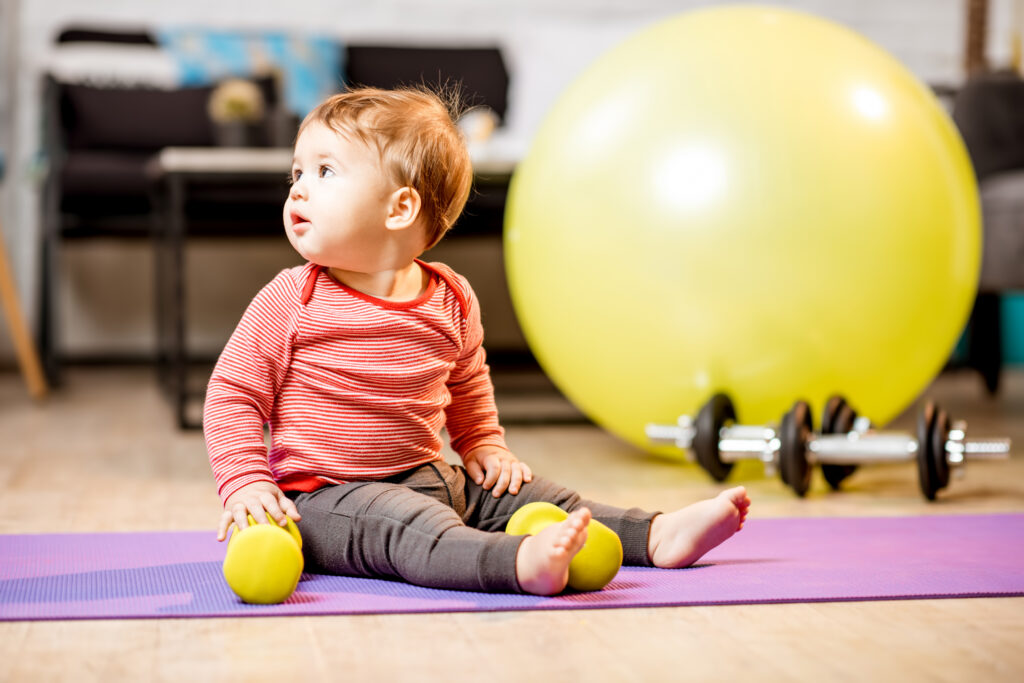Time in the Tummy
During tummy time, you should place your awake, supervising infant on their stomach. Strengthening the muscles in the arms, shoulders, and neck through this activity is critical for upcoming developmental milestones including sitting, crawling, and walking. Additionally, it helps avoid flat patches on the back of the head and encourages the development of motor skills. Tummy time should be done multiple times a day for a few minutes at first, with the duration being gradually increased as your baby gains strength. To entertain and interest your infant, use toys or a mirror. To protect your baby’s safety during tummy time, always keep an eye on them.
Cycle Legs
A simple workout called “bicycle legs” involves moving your baby’s legs in a cycling motion while they are lying on their back. This exercise is particularly helpful for newborns who have colic since it helps strengthen the leg muscles, improves digestion, and may help reduce gas. Holding your baby’s feet, gently press one leg against their chest while straightening the other to execute bicycle legs. Legs should be alternated in a fluid, cycling motion while keeping a soft, steady beat. Additionally, this practice can improve leg coordination, getting your kid ready for more physical activities in the future.
Encouraged Sitting
Supported sitting is providing your infant with assistance while they sit. This exercise helps your infant become ready for independent sitting by strengthening the muscles in their back, neck, and abdomen as well as improving their balance and posture. Place your infant on your lap or a cushioned surface and support them around the waist or chest to do supported sitting. As they become stronger and more balanced, progressively lessen the support so they can sit more on their own. To avoid falls, make sure the surroundings are secure and keep near your child at all times.
Extending and Seizing
Encouraging your infant to reach for and hold toys is known as reaching and grasping. This exercise improves hand-eye coordination, fortifies the muscles in the arms and shoulders, and fosters the growth of the senses and cognition. When your baby is on their back or during tummy time, put toys within their reach. Urge them to reach out and pick up the toys, which come in a range of forms and textures for them to investigate. This practice improves your baby’s exploration and curiosity skills in addition to strengthening muscles.
Turning Over
Assisting your baby to roll over involves moving them from their back to their stomach and vice versa. In addition to strengthening the core muscles, this exercise enhances balance, coordination, and spatial awareness. Help your baby roll over and transfer their weight to help you gently manage their movements. Encourage them to reach and roll by using toys, and offer assistance and encouragement as required. A key developmental milestone that aids in your baby’s development of the motor skills needed for sitting and crawling is rolling over.

Infant Push-Ups
During tummy time, encourage your baby to push up on their hands by performing baby push-ups. This exercise develops coordination and motor abilities, strengthens the muscles in the arms, shoulders, and chest, and gets your baby ready for crawling. Put your baby’s arms beneath their shoulders during tummy time, and encourage them to push themselves up. To get them to raise their head and torso off the ground, use toys or your voice. The strength in the upper body required for more complex motions is developed through baby push-ups.
Draw-to-Sit
Helping your baby transition from a laying to a sitting position is known as pull-to-sit. This exercise enhances balance and coordination, builds strength in the neck, shoulder, and core muscles, and promotes independent sitting. Grasp your baby’s hands or forearms gently and slowly pull them toward a sitting posture to perform the pull-to-sit technique. As they practice this technique, give them encouragement and praise and support their head and neck as needed. This practice also helps your infant learn how to sit up and gets them ready for other activities.
Standing in Harmony
Supporting your infant while they stand is known as standing with support. This practice helps your baby get ready to walk by strengthening their leg muscles and enhancing their balance and coordination. Hold your infant beneath your arms or around your chest, letting them rest some of their weight on their legs, to do this. As they gain strength, gradually extend the period and urge them to walk in little steps while maintaining their weight. Your infant gains the strength and self-assurance necessary for independent standing and walking with the support of this practice.
Slithering
Encouraging your infant to crawl on their hands and knees is known as crawling. This workout develops motor skills and coordination, strengthens the arms, legs, and core, and improves spatial awareness and exploration. As your infant is on their hands and knees, encourage them to go forward using toys or vocal cues. As needed, offer gentle direction and support, and establish a welcoming and secure space for discovery. A vital developmental milestone that aids with your baby’s balance and coordination is crawling.
Baby Dancing
Holding your infant while you dance and move softly is known as “dancing with baby.” This activity stimulates the vestibular and auditory systems, enhances general muscle tone, and fosters sensory development and bonding. Rock, bounce, or gently swing your infant while dancing to music. Keep an eye out for your baby’s comfort level and indications, and make this a joyful pastime for the two of you. In addition to building their muscular strength, dancing with your infant improves your emotional bond and aids in the development of their sense of rhythm and movement.

Incorporating these exercises into your baby’s daily routine is a wonderful way to support their physical development and build a foundation for their future motor skills. Each activity, from tummy time to dancing, not only strengthens your baby’s muscles but also fosters coordination, balance, and cognitive growth. Remember, every baby develops at their own pace, so patience and encouragement are key. Enjoy these moments of bonding and play, knowing that you are helping your baby grow stronger and healthier. With consistent practice and loving support, your baby will be well on their way to reaching their developmental milestones. Embrace this special time and cherish the progress your little one makes each day.


